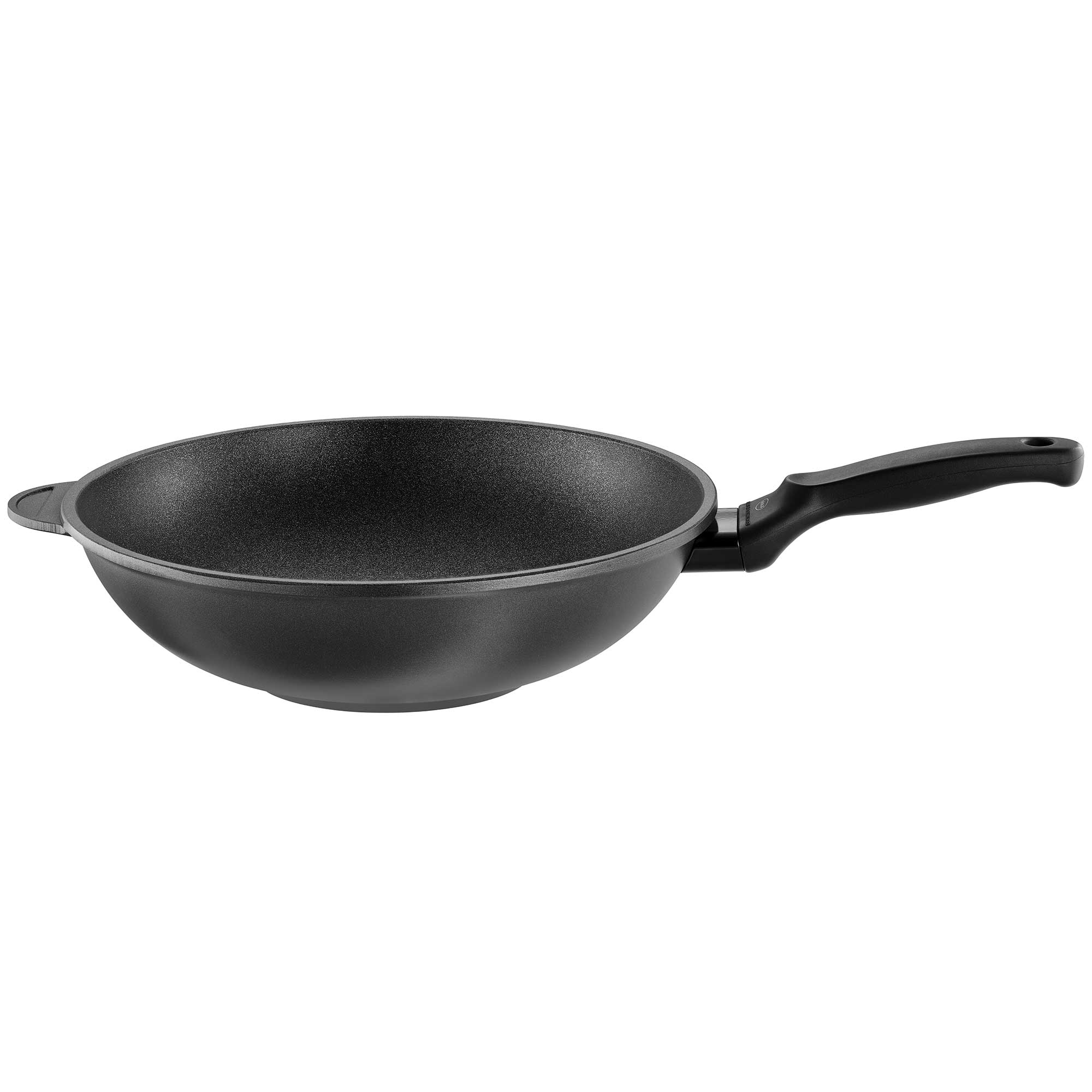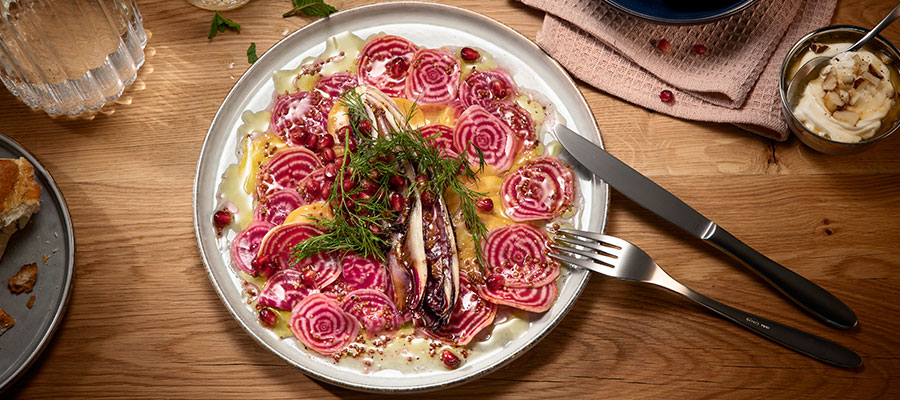For unlimited good taste: woks and wok pans from RÖSLE.
For unlimited good taste: woks and wok pans from RÖSLE
Woks and wok pans are increasingly finding their way into German and European kitchens. These versatile pans are often used to prepare delicious Asian rice or noodle dishes with fish, meat or tofu.
However, high-quality wok pans can do much more, such as braising, deep-frying, steaming or blanching. Above all, however, they transcend all too narrowly defined boundaries of good taste in the kitchen, because of course not only Asian dishes can be prepared in a wok, but also pan-fried dishes from Germany and all over the world.
What distinguishes the wok from the frying pan and the modern wok pan from the traditional semi-circular cast iron wok?
Wok and frying pan: what are the differences and what effect do they have?
The most noticeable difference between a wok and a frying pan is the shape. A classic Asian wok is made of cast iron and is shaped like a hemisphere. The base is rounded so that the heat in the wok spreads to different degrees.
However, the different shapes of frying pan and wok are not just a matter of form. They are conducive to the different ways of cooking and frying in Western and Far Eastern traditions. In Asia, the technique of stir-frying, also known as the stir-fry technique, is often used in the wok.
“Stir” means ‘to stir’ and ‘fry’ means ‘to fry’, which explains the technique: stir-frying and cooking takes place with constant stirring. This is one of the reasons why a wok has such high side walls. As these are also curved outwards, different temperature zones are created in the wok. It is naturally hottest at the bottom, which is why everything that needs and can withstand high heat is fried here first: Meat or tofu, for example. Vegetables are then added, fried briefly and then moved to the more moderate temperature zones on the side walls for cooking.
A traditional Asian wok is made of cast iron and has a rounded base as it was used over an open fire. In the modern kitchen and for use on the stove, however, this shape makes little sense as a lot of valuable energy would be lost. For this reason, woks and wok pans for the European market or for private households usually have a flat base with a diameter that matches the standard dimensions of a kitchen hob.
Classic wok and modern wok pan: differences in shape and material
The wok pan also differs from the wok in its shape. The side walls are lower so that food that is not to be stir-fried can also be seared well in the wok pan. If it has a flat sandwich base, the wok pan can also be used on induction hobs. A non-stick coating prevents food from sticking, but must be particularly robust, especially in the wok, so that it is suitable for cooking and frying using the stir-fry method.
In contrast to the wok, the wok pan does not have handles but, like the frying pan, has a handle which, like the entire pan, must be resistant to high temperatures. The handle also makes it easier to swivel the wok like a frying pan or to hold it firmly when stirring, turning and portioning so that it does not slip.
The wok pan is a particularly versatile piece of cookware, as it can not only be used for frying and stir-frying, but also for deep-frying, steaming, stewing, blanching and braising with the right accessories.
Of course, the wok pan has nothing against a good ramen soup either. However, its actual purpose is to prepare dishes for which individual or all ingredients are fried. As the base has a small diameter in relation to the overall size, this can be done with very little fat. Nuts or croutons can be fried in them.
Asian dishes are characterized by the fact that the vegetables are usually crispier on the table. This is also due to preparation in a wok, which is gentler at high temperatures and therefore preserves nutrients. This is why a wok pan is also an ideal pan for cooking quickly but in small portions rather than in stock.
Of course, a modern wok pan cannot stand up to comparison with an Asian wok, which is used at extremely high temperatures. Nor should it, because as already mentioned, it is designed for use on the hob and therefore also for recipes that are cooked at more moderate temperatures. In addition, the smoke point of a delicious sesame oil or peanut oil (refined) is around 220 °C, which is why a wok pan that can withstand this temperature is perfectly adequate for use on the hob.
Dedicated to sustainability and good taste: Wok pans from RÖSLE
Whether wok or wok pan, Asian cuisine has long since conquered our kitchens and with it the associated cookware. Japanese udon, Korean kimchi chicken, all kinds of fried dishes from Chinese cuisine or an Indian curry are therefore at the top of the list in many households. But traditional German dishes can of course also be fried, stir-fried or steamed in the wok pan.
And so that our wok not only proves to be a boundary-breaker in the kitchen, but also “woke” in a positive sense, i.e. alert and committed, we at RÖSLE have decided to include a wok pan in the CADINI range. After all, CADINI pots and pans are not only excellent in terms of shape and workmanship. They are also made from 100% recycled aluminum in Italy. This means that there is no need to use new aluminum, the wok pans have short production routes and they are ideally suited to the conditions in European kitchens.
Wok pans in the CADINI range are also characterized by their beautiful design and the particularly robust ProResist non-stick coating. They have a particularly sturdy, resistant Bakelite handle, which many people find easy to handle. The pan and handles are also temperature-resistant up to 220 °C, making them just as suitable for preparing delicious stir-fry dishes as they are for searing meat, tofu or fish.
The flat base of our CADINI wok pans fits perfectly on all hotplates and hobs, while the 12 cm high side walls and a rim diameter of 32 cm contribute to a filling capacity of a whopping 4.7 liters. However, please bear in mind that the pan should not be filled to the brim for classic wok cooking.
All woks and wok pans in our range are also suitable for use in the oven and for cleaning in the dishwasher. Stainless steel spatulas or wooden spoons can also be used for turning and stirring in wok pans with ProResist coating.







